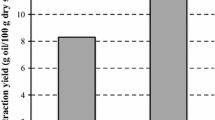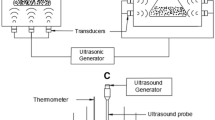Abstract
The ultrasonic extraction of cottonseed with ethyl alcohol is studied. Several treating systems are evaluated with the seed in different positions in regard to the ultrasonic field. A calorimetric method was used for measuring the ultrasonic power to the treating vessels. The ultrasonic field had a frequency of 26 Kc/sec, and there was a power range from 0 to 2 watts/cm2. The temperature was varied between 25 and 75C for a set of runs, and a solvent flow rate of about 1 ml/sec was used for most runs. It appears that the temperature effect is the same for runs with and without ultrasonics. A capillary flow mechanism is discussed to explain the temperature effect. Only the extraction without ultrasonics could be predicted by the latter model at a given temperature level.
Considerable improvement in the extraction rate was obtained when the ultrasonic pressure gradient was used parallel to the main solid liquid interface. A generalized empirical equation is presented, relating the rate of extraction to the calorimetric power to the extraction vessel, the total area normal to the ultrasonic field, and the seed loading for a particular geometry. By using Fick's law of diffusion and a simplified physical model, the data are also presented as an equation of the diffusion coefficient as a function of the calorimetrically measured ultrasonic power, the total area in the path of the ultrasonic field, and the seed loading.
Similar content being viewed by others
References
Marinesco, N, “Propietes Piezo-Chemiques Physiques et Biophysiques des Ultrasons,” Herman et Cie., Paris (1937).
McKittrick, D. S., and Cornish, R. E., U.S. Patent 2,265,762 (1941).
Thompson, D., and Sutherland, D. G.,I. E. C. 47, No. 6, 1167 (1955).
Henry, G. E., U.S. Patent 2,827,978 (1958).
Carlin, B., “Ultrasonics,”2nd ed., McGraw-Hill Book Company Inc., New York, N.Y. (1960).
Bennet, G. S.,J. Acous. Soc. of Am. 24, 470 (1952).
Mikhailov, I. G., and Shutilov, V. A.,Soviet Physics Acoustics 3, No. 4, 410–411 (1957).
Szilard, J., “Ultrasonic Intensity Measurement by Compensated Calorimeter, Proc. of the 3rd Int. Congress on Acoustics,” Stuttgart, 1959, Elsevier Publishing Company, Amsterdam, The Netherlands, 1961, p. 1248.
Othmer, D. F., and Agarwal, J. C.,C. E. P. 51, No. 8, 372 (1955).
Fan, H. P., Morris, J. C., and Wakeham, H.,I. E. C. 40, 195 (1948).
Sole, P., “Alcoholic Extraction of Oilseed with the Aid of Ultrasonics,” Doctoral Dissertation, Polytechnic Institute of Brooklyn, June 1965, available in Xerox form from University Microfilms, Ann Arbor, Mich.
Author information
Authors and Affiliations
Additional information
From a doctoral dissertation (chemical engineering) at the Polytechnic Institute of Brooklyn. Presented at III Inter-American Convention of Chemical Engineers, Mexico, October 1966.
About this article
Cite this article
Schurig, W.F., Sole, P. Alcoholic extraction of oilseed with the aid of ultrasonics. J Am Oil Chem Soc 44, 585–591 (1967). https://doi.org/10.1007/BF02901256
Received:
Issue Date:
DOI: https://doi.org/10.1007/BF02901256




